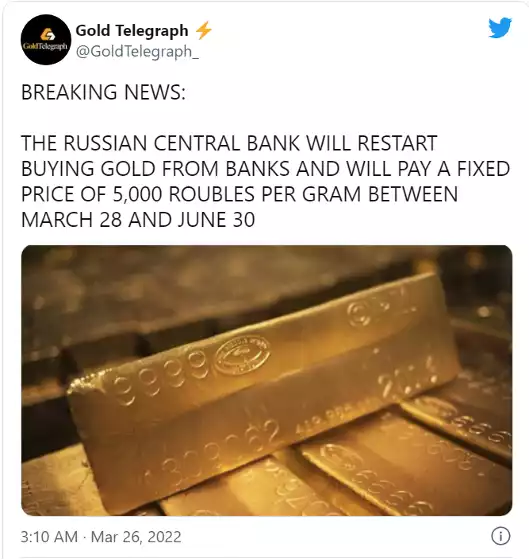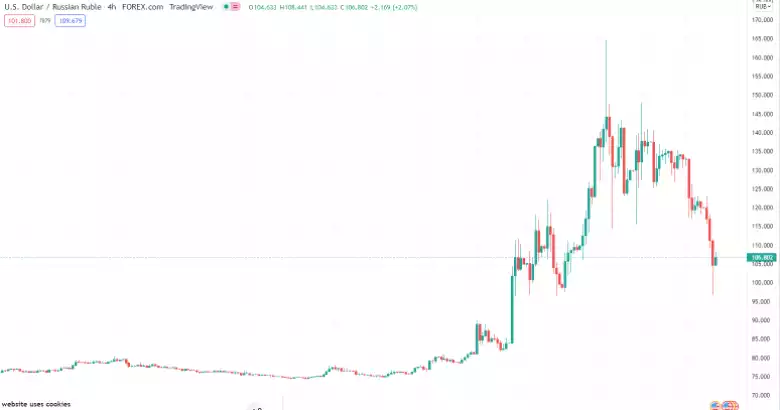Russia Accepting Rubles and Gold for Oil and Gas
News
|
Posted 31/03/2022
|
9558
Russia is demanding payment in Rubles for Oil and Gas with a number of Finance Ministers from NATO countries pushing back. German Finance Minister Christian Lindner said his country wouldn’t be paying Rubles for energy imports. The deadline of 31 March (today) has been extended due to a recognition of ‘technical challenges’ in changing over the currency of the €200-800 million per day paid by the EU collectively to Russia.
Italian Prime Minister, Mario Draghi weighed in saying that changing the currency of payment for existing contracts would be a violation of the existing agreements. Russia has been cut out of the global payments system SWIFT by NATO sanctions and their reserves held in hostile nations have been frozen, these changes are likely a response to the economic sanctions placed on them.
Europe relies on Russia for approximately 40% of their gas imports, however this is not an even ratio with some countries being more or less completely dependent such as Hungary which gets 95% of their gas from Russia. The European Commission has said it plans to reduce its reliance on Russian gas by better than two-thirds by the end of 2022, however it would need to continue bringing in Russian supplies until as late as 2030 before making a complete break. Approximately 4 million barrels of oil are imported into the EU daily, however this is not as significant as the gas trade.
The currency wars are heating up as Russia has now presented an ultimatum, and European countries are threatening to reduce their dependency long term and source energy from other countries. On Twitter the hashtag #GotGoldOrRubles has been trending with rumours swirling of Russia taking payment in gold or bitcoin for oil and gas. Reportedly, ‘friendly countries’ are able to settle with Bitcoin, and ‘unfriendly countries’ (i.e. sanctioning countries freezing Russian assets) are required to pay with Rubles or Gold.
Kremlin Spokesperson Dmitry Peskov told reporters on Monday, “Moscow is handling the details of its gas delivery plans to unfriendly countries for payment in Rubles, but it won’t engage in charity if Europe refuses to pay in the Russian currency”. Questioned as to what Russia would do if payment in Rubles wasn’t forthcoming, the spokesperson responded that ïssues should be sorted out as they develop, but we will definitely not supply gas for free.” Another Kremlin representative has hinted that “It would be right - where it is beneficial for our country - to widen the list of export products priced in rubles to include: fertilizer, grain, food oil, coal, crude oil, metals, timber. As a major commodity exporter, Russia is able to demand payment in their own currency, if they are able to live with the initial, and potentially long-term, hit of the loss of forex inflows.
The Russian Central Bank is buying gold from banks at a rate of 5,000 Rubles per gram (AU$2170/oz) from 28 March to 30 June. We would also love to buy gold for that price, but it does make it clear that Russia is purchasing gold, not selling. Given that the peg is significantly below the prevailing spot price, it is hard to speculate why Russia didn’t go with a higher ratio like 8,000 rubles to the gram for the get go.

This rate is emerging as an initial peg to gold, 155,500 Rubles to the troy ounce, which can be revised to revalue the Ruble backed by gold. After the value of the Ruble fell dramatically since the announcement of the Ukrainian invasion in late February, the USD/RUB rate may be bottoming with various FOREX websites having a low of 165 Rubles to the dollar, and at time of writing an exchange rate of 88 - 106. As the Ruble is strengthening in the last two weeks, fewer Rubles are required to exchange for each US Dollar. You can see the price stability in the month leading up to the invasion and that the spike is now coming down.

As the Ruble returns to the old norm of 75, the USD price of gold is predicted by some pundits to rise structurally as it has a peg to gold. While many of the details aren’t clear, and settlements between countries in gold are opaque at best, it has been a long time since a country was willing to buyback its own currency in exchange for gold at a fixed rate. It sounds like some sort of “Gold Standard”.
With the current purchasing power of the Ruble depressed, 5000 Rubles per gram of gold is below market, however, if the Ruble strengthens much beyond its pre-war exchange rate of 75:1, importers will be able to purchase oil and gas at a discount if they use gold. The last question is what happens after 30 June when the Gold/Ruble rate may be changed.
On the eve of the Ruble payment deadline, Putin has argued that trust in the US Dollar has taken a major blow, and that many countries are now starting to convert their paper assets into real reserves of raw materials, land, food and gold. Chairman of the Congressional Energy Energy Committee, Pavel Zavalny has added, “The dollar ceases to be a means of payment for us, it has lost all interest for us.” Later in the interview he stated, a preference for ‘hard money’ like Gold, or for friendly countries, they are happy to accept their currency or Bitcoin: “If they want bitcoin, we will trade in bitcoin.”
With record debt and fake money flooding the fiat system, there is certainly a first-mover advantage for the sovereign nation(s) that move towards a gold-backed currency. Few expect the US Dollar to go the way of the dodo, however, it is clear that we are increasingly moving to a multi-polar world where dollar alternatives present new focal points in a more decentralised system where prices are based on real assets and usage, rather than paper and derivatives.